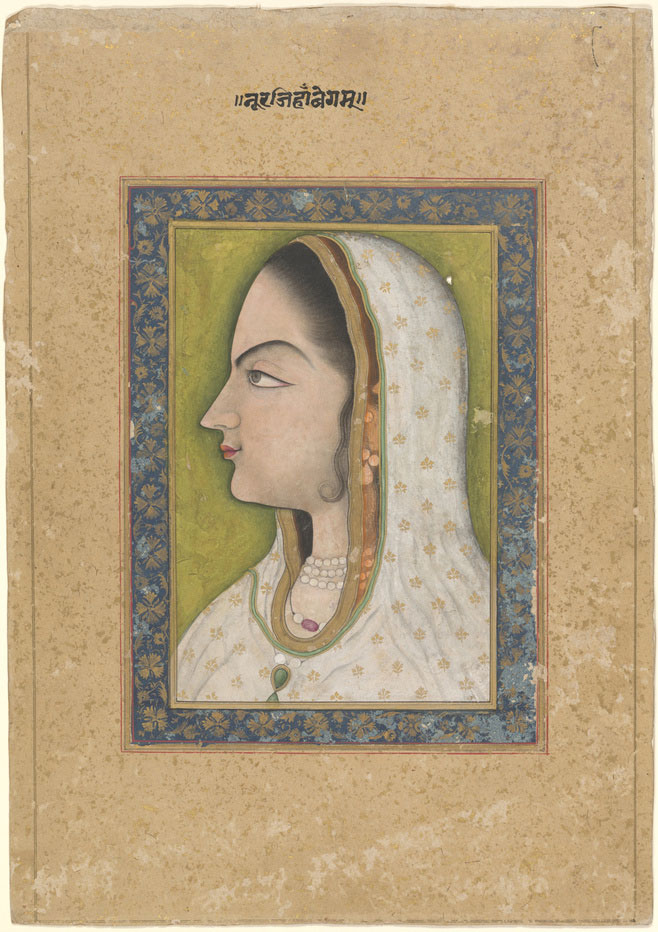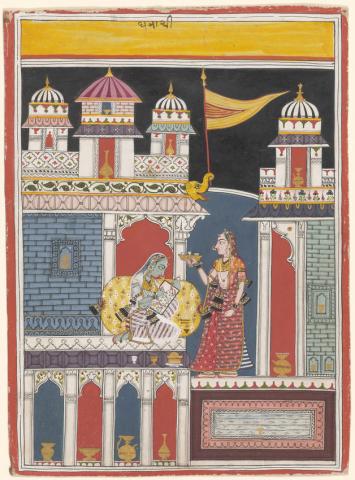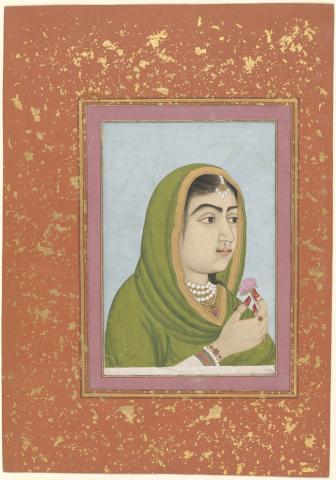While the identity of most portraits in the Walter collection of Indian paintings at the Morgan remains obscured, an eighteenth-century portrait (M.1074.1) identifies the subject as “Nur Jihan Begum” in Nagari script. This painting has since been interpreted as an idealized portrait, “an imaginative rendering.”1 Such portraits were often commissioned by the Rajput courtiers in Rajasthan.2 The artist incorporated Mughal and Rajput conventions to bring the idealized portrait to life. By the early 1700s, the largest Rajasthani courts developed their own stylistic traditions of painting that went on to make the corpus of Mewar, Bikaner, Bundi, Jodhpur, and Jaipur styles. Based on inventorial evidence from Rajput courts, Molly Aitken has suggested that these courts organized paintings by subject matter rather than stylistic distinction, which was a preferred rubric of the Mughal emperors.3 In all likelihood, the Morgan Nur Jahan would have been grouped under paintings that were deemed “pictures of women” by historical viewers.4 Mildred Archer praises collector Paul F. Walter for acquiring a collection of Rajput paintings that represent the myriad painting styles of the region. 5 I further add that it was at the discretion of collector Anna C. Walter that the Walter collection was able to include a sampling of genre scenes of elite Mughal women painted by artists working in Delhi and Rajasthani court ateliers. Further scholarship into her motley collection would be useful in understanding how the gender turn in Mughal South Asian studies benefits from these lesser-known pockets of knowledge hiding in the archives.
Mughal Empress Nur Jahan (1577–1645) was a successful merchant, an avid embroiderer and inventor of courtly fashion, an architect of lavish gardens, connoisseur of luxury arts, and the favorite consort of Emperor Jahangir (r. 1605–27).6 The eighteenth-century Morgan portrait of Nur Jahan painted in direct profile shows the Empress with a slightly upward gaze, perhaps contemplating the scene that lies ahead of her, beyond the viewing pleasures of the onlooker. Her profile casts a subtle shadow onto the olive green background—either a colored wall or the body of a textile draping the interior behind—further drawing us into the mysterious space from which the Empress casts her majestic gaze.
Nur Jahan Begum is wearing a string of pearls wrapped thrice around her neck, reflecting her imperial position and Mughal courtly fashion of the earlier decades. A pair of string necklaces accompanies this strand of pearls: the one resting on her neck has a rectangular red ruby or spinel flanked by a pair of pearls; the other necklace resting on her chest is made of a pair of tear-drop-shaped green emeralds. A pearl earring of unusual shape adorns her left ear, peeking through the transparent red border of the white odani (scarf). Upon closer inspection, the painting reveals that the Empress is not wearing one but two odanis. The transparent red odani with the thick gold zari border sits directly on her well-oiled, carefully brushed hair, taut under the white odani with thin gold and green border, woven with five-leaved sprays in gold thread. Another painting (M.1041.2) in the Walter collection, this time from the Malwa school in Madhya Pradesh, predating our protagonist by almost half a decade, depicts a scene in which the sakhi (female companion), holding a tray full of cups of paints for her lady, is seen wearing a traditional red odani with zari border, similar to the one peeking through the white muslin of Empress Nur Jahan in the Bikaner painting. The addition of the semi-transparent white odani in the Nur Jahan portrait attests to the painter’s knowledge of the Mughal Empress’s well-known love and fascination for the sumptuous Dacca white muslin. The Empress constantly reinvented and incorporated this textile into the seventeenth-century repertoire of Mughal courtly fashion.7 However, fine muslins were diaphanous in nature. The white cloth portrayed here is translucent. It could indicate do dami, a cloth similar to muslins, produced in the Malwa factories and made popular by Emperor Shah Jahan in the second half of the seventeenth century.8 It seems probable, then, that the Bikaner painter portrayed these familiar and foreign luxury textiles to further make the painting an object of opulence. Other idealized portraits of Nur Jahan from this period picture her in a fine muslin upper garment with bare breasts.9 A Mughal painting in the Cleveland Museum of Art’s collection depicting a woman holding a portrait of Emperor Jahangir likely served as the template for later genre scenes depicting Nur Jahan in Rajput courts.10 Here she is seen wearing a white muslin jama (stitched coat) and her head is covered with a red diaphanous odni. Her arched eyebrow, half-closed eyes, and a strand of curling hair in the Cleveland double portrait continue to be cited by later painters across the length and breadth of the northwestern courts.
The unusual treatment of the eyes and hair sets the Morgan Nur Jahan portrait apart. A clump of carefully drawn, curled hair delicately frames the Empress’s cheek. Her arched brow and heavily-lidded eyes are reminiscent of Radha’s gaze, which torments her lover, Krishna, in the twelfth-century Sanskrit epic poem Gita Govinda. The half-closed, almond-shaped eye and small volute mouth are not characteristically “Mughal” in style either.11 This convention anticipates the style of painting idealized portraits that became popular towards the end of the eighteenth century in the Rajput court of Kishangarh. Despite the idealized features, the artist of the Morgan portrait seemed to have retained some semblance of reality: the Empress is not in her youth; she has matured. Her hair is combed backwards, and her upper body is covered in a heavier yet delicate white textile. The halo is reduced to a subtle shadow tracing her head, and minimal jewelry makes her seem more ascetic than imperial.12 Since this idealized portrait was painted almost half a century after the Empress passed away, could the painter be evoking a sense of the afterlife through a muted rendering of his deceased subject? Are we witnessing an artist experimenting with the styles of the Mughal atelier while incorporating his own signatures in order to arrive at a more matured convention? Are we witnessing an artist’s reinvention of his hand in order to secure a more stable patronage?
Although we do not know who painted the Morgan portrait of Nur Jahan, a contemporary half-length portrait of a woman (M. 1034r) from the Mughal court shares some thematic similarities. It was painted in the newly reinstated Mughal court atelier during the rule of Emperor Muhammad Shah (r. 1719–48). Both paintings show a bust of a woman depicted in profile against a monochromatic background, wearing similar ornaments. One of the court painters of Emperor Muhammad Shah, Kalyan Das or Chitarman II, gained popularity for his depiction of idealized court women, similar to the one seen here.13 The painter of this portrait seemed to have slightly altered the compositional rubric by arranging the bust in a three-quarter profile, including her henna-dyed hands holding a rose, and a white railing, lending a sense of interiority to the picture.
No objective portrayal of Mughal women exists since women of the royal household were not accessible to the public. Their unseen (pardanashin) worlds invoked the curiosities of onlookers, poets, artists, and even modern-day collectors. Having never seen the Empress, the Bikaner painter resorted to idealized standards and idioms of female beauty to bring her image to life. The Morgan Nur Jahan portrait is ultimately an abstracted and stylized depiction of the most popular Mughal queen of early modern South Asian history. The interplay between reality and artifice enriches the imaging and imagining of the powerful Mughal Empress, who invoked the curiosity of courtiers and foreigners alike. Perhaps Anna C. Walter also collected “pictures of women” in 1980s America to come closer to the legacy of Empress Nur Jahan, just as the Rajasthani courtiers did in the eighteenth century.
Debarati Sarkar
College Ambassador, 2023–2024
The Morgan Library & Museum
Endnotes:
- Pratapaditya Pal, Barbara Schmitz, 1997, xxii.
- A group of Hindu kings and chieftains who ruled the smaller, less powerful kingdoms in the northwestern part of Mughal Hindustan (1526–1858). They rose to power after the decline of the Mughal Empire toward the end of the seventeenth century.
- Aitken, 2010, 70.
- Ibid.
- Archer, 1981, 313.
- Lal, 2018.
- Manfredi, 2017, 41.
- Houghteling, 2022, 66.
- For a list of idealized portrayals of Nur Jahan, see Vogel, 2018.
- See “Nur Jahan Holding a Portrait of Emperor Jahangir” (c. 1627) Cleveland Museum of Art (2013.325).
- See “Radha, the Beloved of Krishna” (c. 1750) Metropolitan Museum of Art (2005.370).
- Compare this with the “Portrait of a Lady” (c. 1600s) RISD (17.478), one of the earliest versions of this type.
- See “A lady” (c. 1750) by Kalyan Das in the Johnson Album 60, no. 22, British Library.
Bibliography
- Aitken, Molly. Intelligence of Tradition in Rajput Court Painting. New Haven; London: Yale University Press, 2010.
- Archer, Mildred. “Review of The Classical Tradition in Rajput Painting from the Paul F. Walter Collection, by P. Pal.” Journal of the Royal Society of Arts 129.5297 (1981): 313–14.
- Falk, Toby and Mildred Archer. Indian Miniatures in the Indian Office Library. Sotheby Canada, 1981.
- Houghteling, Sylvia. The Art of Cloth in Mughal India. Princeton University Press, 2022.
- Lal, Ruby. Empress: The Astonishing Reign of Nur Jahan. New York: W.W. Norton & Company, 2018.
- Lal, Ruby. Domesticity and Power in the Early Mughal World. Cambridge, UK; New York: Cambridge University Press, 2005.
- Manfredi, Paola. Chikankari: A Lucknawi Tradition. Niyogi Books, 2017.
- Ryskamp, Charles, ed., Twenty-First Report to the Fellows of the Pierpont Morgan Library, 1984–1986. New York, 1989.
- Schmitz, Barbara. Islamic and Indian manuscripts and paintings in the Pierpont Morgan Library. New York: The Library, 1997.
- Safrani, Shehbaz H. Aspects of Indian Art and Life (catalogue of an exhibition at The Queens Museum, 23 November 1983–5 February 1984). New York, 1983.
- Vogel, Rachel. “Portrait of a Lady, Copy of a European Painting (Painting, Recto; Text, Verso), Folio from a Manuscript, 18th century.” Digital publication for Women in South Asian Art, Harvard Art Museums (2018).



